M
|

"The Father of Canadian Karate"
It can be positively stated Karate in Canada owes its mass introduction and development to one person MASAMI TSURUOKA, 9th dan, Tsuruoka Karate-do Federation. Almost single handedly Masami Tsuruoka sensei had kept Karate before the Canadian public in the early beginnings, 1958 - 1968, through newspaper articles, magazine articles, frequent demonstrations as well as appearances on public television and numerous exhibitions across Canada.
Born in Cumberland, British Columbia, Canada on January 12, 1929 as a teenager Masami Tsuruoka moved to Kumamoto, Japan in 1945 with his father shortly after the conclusion of World War II. (The Tsuruoka family as with most Japanese families living in Canada at that time, was placed in 'Internment Camps' for a few years in Tashimi, B.C. and later at Roseberry.)
Shortly after moving to Kumamoto, a popular rumour has it that a gang of street punks subjected Masami to a severe beating. This episode led him to seek Karate instruction from a Karate master in the area.
Another rumour indicates that while on a brief trip to Tokyo with his father, Masami Tsuruoka witnessed a Karate demonstration and became so enthralled with what he saw, that he made it a point upon his return to Kumamoto, to find a Karate teacher and begin practice. Regardless of which rumour is believed the Karate master that he sought instruction from was Dr. Tsuyoshi Chitose, 10th dan founder of the Chito-ryu system of Karate-do.
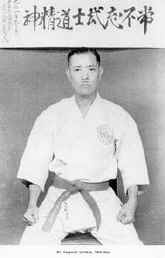
Master Tsuyoshi Chitose, 10th dan.
Founder of Chito Ryu style of Karate-do.
As Masami Tsuruoka advanced in his physical training his attitude and thought process matured. Instead of approaching manhood with a 'chip' on his shoulder, he attained with Chitose sensei's guidance, serenity and peace of mind through the study of Karate-do. These acquired capabilities gave Masami the confidence that helped him look above such attitudes as vindictiveness. He learned that if necessary he could face the taunts of the street gang members and only feel profound sympathy for them. He felt all students of Karate-do, if schooled correctly, should be able to reach this plateau over time.
During 1949, he received his first-degree black belt from Master Chitose.
As Masami kept improving his training, he began to advance progressively up the promotion ladder of rank. Before returning to Canada in 1956 and finally settling in Toronto, he would obtain the level of 3rd degree black belt.
Convinced by many friends to share his knowledge of this mysterious art, Masami Tsuruoka sensei began teaching in 1957 at a small fitness gym called Mac's Gym (owned and operated by friend, Mac Mia.).
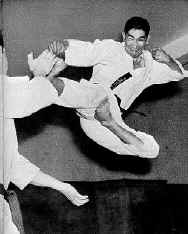
Tsuruoka sensei executing a flying side kick.
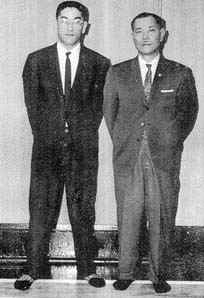
Tsuruoka sensei & Chitose sensei.
Encouraged by a group of members to permanently establish a separate training facility of his own, Masami Tsuruoka eventually secured space over Lakeside Bowling Alley in the Queen Street/ Lansdowne area in 1958 and began giving Karate instruction at the first Karate Club in Canada.
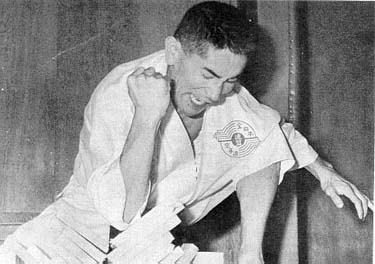
Tsuruoka sensei demonstrating the power of the elbow strike.

(L-R): Dr. Ned Paige, Masami Tsuruoka.
Since then, many from the original group of students continue to be an integral part of the Tsuruoka organization. Some however, have gone on to develop or introduce other systems. Among the most notable members were Benny Allen (Eastern Karate Schools - teacher of Wally Slocki, Tony Facetti, and Teddy Marton), Dr. Ned Page (Wen-Do creator), Shane Higashi (Canadian Chito-Kai Federation). Also, Qai Wong (Wong's Shorin-ryu Karate/Kung Fu Society), Kei Tsumura (Shito-ryu Itosu-kai Karate and Kobudo Association of Canada), Monty and Nathan Guest (Kaishin Kan Karate Organization). Fern Cleroux (Cleroux's Chito-ryu Karate), Joe Gilles (Shotokan-Nishiyama Group). Alcide Bourque (New Brunswick) could be included as well as Andre Langelier, George Sulvaine (Ottawa), Tug Wilson (Winnipeg) and Tran Quan Ba (University of Montreal).
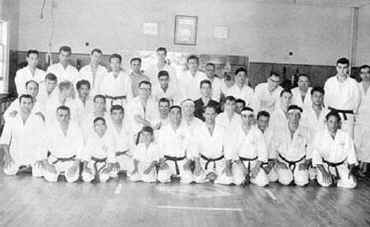
Front Row (L-R): Alcide Bourque, Ron Forrester, David
Tsuruoka, Jimmy Immamura,
Kenny Paige, Masami Tsuruoka Sensei, unknown, Bill Melbourne (sweatband),
Tony
Facetti, Bill Doyle (sweatband), & Ned Paige.
Second Row (L-R): unknown, Dave Gellman, Ron Wilson (looking to his left),
Dave
Chong, Monty Guest, Doug Harder (glasses), unknown, Benny Allen (sweatband),
behind & to left of Tsuruoka Sensei, & Shane Higashi last person in the row.
Back Row (L-R): John Matsumoto, Loney Pike, unknown, unknown, unknown,
unknown, Nathan Guest (2nd person directly behind Tsuruoka sensei leaning forward),
Henry
Ueyda, (glasses).
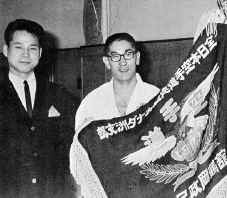
(L-R): Shane Higashi, Masami Tsuruoka.
By late 1962, Tsuruoka sensei was officially appointed as Chief Representative for the Chito-ryu Karate system in Canada. An American colleague, Mr. William J. Dometrich of Kentucky, who also received personal instruction during the early 1950's at the Yoseikan Dojo in Kumamoto, Japan, was appointed the USA representative.
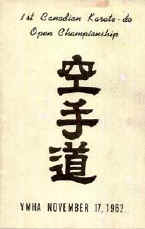
In 1962 the 1st Canadian Karate Open Championships was organized by Tsuruoka sensei and became the first Karate tounament ever held in Canada. It was in 1962 also that Tsuruoka sensei began teaching Karate classes at the University of Toronto and held the first summer camp called Kamp Kamikaze near in Northeastern Ontario which was open to all styles.
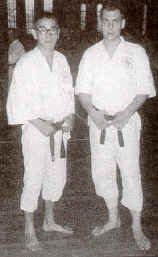
(L-R): Masami Tsuruoka, William Dometrich.
Approximately during this period Bruce Lee the world famous Chinese martial artist/movie star corresponded with Tsuruoka sensei requesting his opinion on 'How to better teach non-oriental students'. Bruce Lee also inquired about other related martial arts viewpoints including martial art philosophy. (Tsuruoka sensei still possesses the correspondents (2-3 hand written letters) from Bruce Lee in a very safe place).

Bruce Lee
Masami Tsuruoka sensei's wife Kei, was also teaching at the dojo. She taught for approximately 15 years and was certified a 3rd dan in Chito-ryu Karate-do.
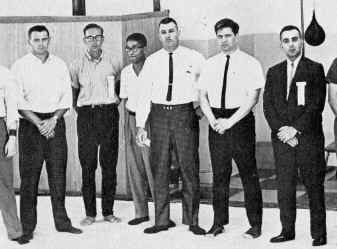
(L-R): Phil Koeppel (United States Karate Assoc.), George E. Mattson (USA Uechi
ryu),
Masami Tsuruoka (Chito-ryu Canada), Robert Trias (USA Shuri-ryu),
Ed Parker (USA
Kenpo-Karate), Anthony Mirakian (USA-Okinawan Meibukan Goju-ryu).
Photo taken in 1963. (Chicago, IL).
By 1963 one of the top students of Tsuruoka sensei Shane Higashi competed at the 2nd Canadian Karate Open Championships in Toronto and won 1st place in the fighting category.
The 1964 championships were renamed as the Canadian International Open Karate Championships that attracted competitors from across Canada, USA, Japan and Hawaii.
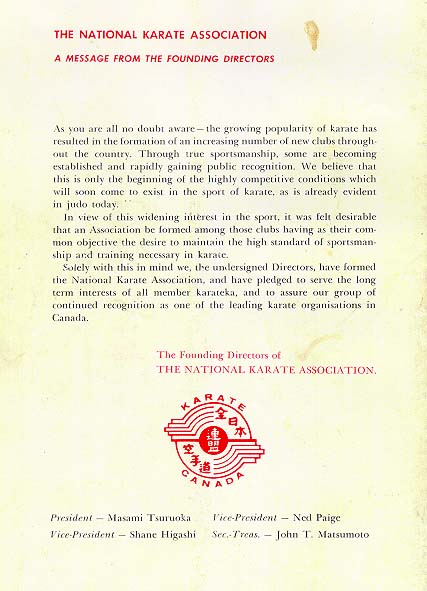
It was during 1964 the concept of a unified karate organization was first introduced in Canada by Tsuruoka sensei.
In 1965, Tsuruoka sensei received his 5th dan from Master Chitose.
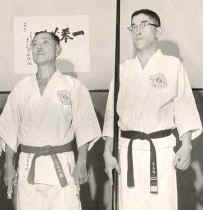
Master Chitose & Tsuruoka sensei.
On October 3,1965 the Canadian International Open Karate Championships hosted by Tsuruoka sensei was won by a top fighter from Okinawan named Zenpo Shimabukuro. Also during 1965, the inaugural Canadian National Exhibition Karate Championships were held. The championship title was won by another one of Tsuruoka sensei's top fighters, Mr. Fred Boyko.
Tsuruoka sensei moved his dojo to a prime location in downtown Toronto on Yonge Street during 1965.
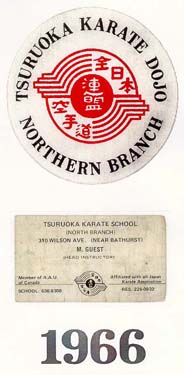
During 1966, Monty Guest became Head Instructor for Tsuruoka sensei's first branch dojo in Toronto.
In 1967, Canada's Centennial Year, Tsuruoka sensei invited Master Chitose and one of his senior students Yamamoto Mamoru sensei to visit Canada for it's grand Centennial celebration. The event was held at the Japanese Canadian Cultural Centre's Nisei Karate Club under the direction of Sensei Kei C. Tsumura.
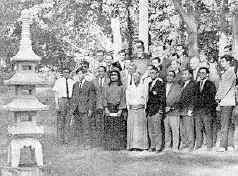
Front Row (L-R): Sam Hayashi (Nisei Karate Club), unknown,
unknown, Yamamoto sensei (long hair), Grand Master Tsuyoshi
Chitose,
Tsuruoka sensei, Tom Saito (Nisei Karate Club), unknown,
David Akutagawa, Mike Foster (Florida).
Second Row: (L-R) Sensei K. C. Tsumura in sun glasses (Nisei Karate Club),
Hal Henschel (between Yamamoto sensei and Chitose sensei) and
George Sulvaine (between unknown and David
Akutagawa).
(Photo taken in back garden of Japanese Canadian Cultural Centre in Don Mills, Ontario.)
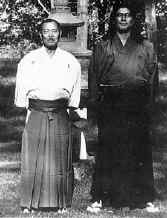
Grand Master Tsuyoshi Chitose and top pupil Yamamoto sensei.
Over the next few years the finalization of the formation of an official 'Sports Governing Body' for Karate was realized. It became known as the National Karate Association of Canada (N.K.A.) with Tsuruoka sensei as it's first President.
By 1970, the first official World Karate-do Championships representing 'All-Styles' was held in Tokyo, Japan and hosted by the newly formed World Union of Karate-do Organizations, (W.U.K.O.). The NKA sent a fighting team with Tsuruoka sensei and Mr. John Carnio (from Toronto) won a silver medal.
During the 2nd WUKO World Karate-do Championships in Paris, France, a deep division developed in the World Organization. A split occurred and a second organization named International Amateur Karate-do Federation was formed also representing Karate.
Tsuruoka sensei's foresight allowed Canada through the NKA to support both Federations (IAKF & WUKO) by sending competitors to both official World Championships for many years after the split.
In November 16, 1973 in Rio de Janeiro, Brazil official representation from amateur Karate in the Western Hemisphere unanimously agreed to form the Pan-American Karate Union and Masami Tsuruoka sensei was elected 1st Vice-President with the Executive Director being Hidetaka Nishiyama.
During 1974, he was instumental in the formation of the Provincial Sports Association responsible for governing all styles of karate-do in the Province of Ontatio, known as the Karate Ontario Association.
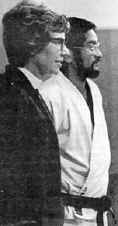
(L-R): Doreen Davies 1st President of Karate Ontario & Tsuruoka sensei.
She was one of two women that were elected into office as
President of the Amateur Athletic Union in the 90 odd year existence of the
A.A.U. of Canada.
Throughout the mid to late 1970's Tsuruoka sensei became increasingly disillusioned with the direction the Chito-kai Federation was going. Then in 1979, Masami Tsuruoka sensei established his own organization, and his former senior student, Shane Higashi, became the leader of the Canadian Chito-kai (Chito-ryu Karate Association) under Chitose sensei.
The new organization was simply referred to as Tsuruoka Karate-do.

Tsuruoka sensei instructing kata.

Tsuruoka Karate-do.
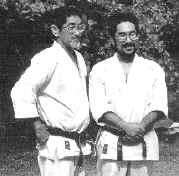
Father and son.
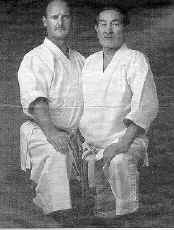
During the 1980's and 90's he continued to further develop his organization with the help of his son David and other important key members such as Dartmouth, Nova Scotia's, Sensei Ron Fagan, 6th dan Chief Technical Director of the Canadian Tsuruoka Karate-do Federation.
In 1986, the Government of the Province of Ontario, Canada established 'The Order of Ontario' to recognize those persons who have rendered service of the greatest distinction and of singular excellence in any field of endeavour benefiting society in Ontario or else where.
The Order is awarded annually to the most outstanding residents of Ontario possessing the above qualifications.
On Wednesday, May 27, 1998 Master Tsuruoka received the Order of Ontario presented by the Lieutenant Governor of the Province of Ontario, the Honourable Hilary Weston.
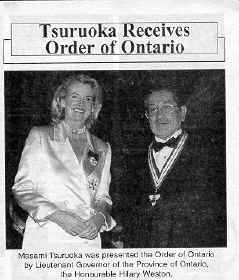
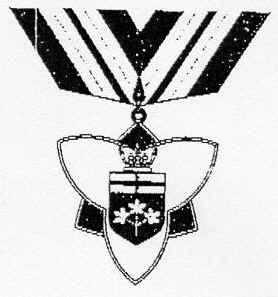
Masami
Tsuruoka was presented the Order of Ontario by the
Honourable Hilary Weston,
Lieutenant Governor of the Province of Ontario.
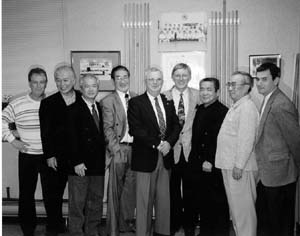
A recent photo of some of Tsuruoka sensei's original students and friends.
(L-R): Monty Guest (founder of Kai Shin Karate),
John Hatashita (brother of the late Frank Hatashita -
father of Canadian Judo),
Quai Wong (formed Eastern Karate along with Benny Allen and later formed Wong's Karate and Kung Fu
Society),
Sensei
Tsuruoka,
Ron Forrester (essential in forming Jiu Jitsu in Canada),
Hal Batke (first director of C.J.A., and former student of Ron Forrester),
Takeshi Kimeda (introduced Aikido to Canada in 1961),
Sam Wong (first to promote Kung Fu in Toronto during 1960's), and
Ken Hayashi (former student of Tsuruoka, sensei and present day Athletic Commissioner of
Ontario).
At 70 years old, Tsuruoka sensei is still actively training and teaching to this day. He continues to be an inspiration to many martial artists from different organizations.

(L-R) Sam Moledzki, President Shito-kai Canada, Betty
Mochizuki,
O'Sensei Tsuruoka, Kyoshi Patrick Mc Carthy.
June 1999, Toronto, Canada.
Bibliography
Black Belt Magazine, World's Largest Magazine of Self-Defense: Black Belt Inc. - Nov-Dec 1964.
Black Belt Magazine, World's Largest Magazine of Self-Defense: Black Belt Inc. - March 1965.
Samurai Magazine, Official Publication of All-American Karate Federation - November 1974.
Black Belt Journal, The Karate Ontario Newsletter: Article by Frank Foulkes - Summer 1993.
Martial Arts Features & Profiles Magazine - Vol. 3, Issue 6.
Karate Do, Karate Ontario Publication - Vol. 1, No. 1 - April 1975.
Bugeisha, Traditional Martial Artist: March 1997, Issue #2 - Article by John Sells.
Baehr Frank, Toronto, Canada - Personal data/photo collection.
Guest Monty, Kai Shin Karate Association - Personal data/photo collection.
Moledzki Sam, Toronto, Canada - Personal data/photo collection.
The Toronto Sun Newspaper - Friday, May 29, 1998 : Article by Steve Buffery - Olympic Sports.
Corcoran John/Farkis Emil, Martial Arts-Traditions, History, People. New York: Gallery Books, An Imprint of
W.H. Smith Publishers, Inc., 1983.
Bowerbank Andrew - The Spirit of Karate-do, The Teachings of Masami Tsuruoka (ISBN 0-9682528-0-X) Morris Marketing and Media Services Inc. 1997.
Bowerbank Andrew - Spirit of the Sensei, A Study of Japanese Martial Arts (ISBN 0-9682528-1-8) Morris Marketing and Media Services Inc. 1998.